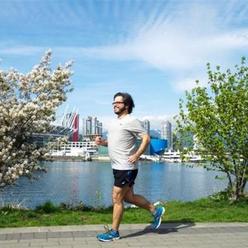Like many niche professions or sub-cultures, runners have their own language that can often seem incomprehensible to novices. A while back, I took a look at some of the most common running acronyms and abbreviations. This series of posts will take an in-depth look at a “running lexicon” of words you will be sure to hear if you hang out among runners for long enough.
![]()
Today, we’ll begin with words starting with the letters A-G:
Altitude training: Training at high altitude acclimatizes a runner to the lower level of oxygen available in the atmosphere. This increases the number of red blood cells, improving the delivery of oxygen to the muscles, lead to better performance when the runner returns to lower altitudes.
Anaerobic Threshold: The running intensity at which lactate (more specifically, lactic acid) starts to accumulate in the blood stream (also called Lactate Threshold). This happens when lactate is produced faster than it can be removed (or metabolized) in the muscle. Anaerobic Threshold is a useful measure for deciding exercise intensity for training and racing. It varies between people and can be increased with training.
Bandit: A runner who enters a race unofficially, without having registered or paid for an entry.
Bib: The piece of Tyvek (or similar material) that runners pin to their bodies. Race bibs include a race number to identity the participant,and usually include a timing chip that records their result.
Black Toenails: Black toenails happen when toes repeatedly come in contact with the top or edge of a running shoe. This causes pressure that results in bleeding under the toenail, often resulting in the toenails to appear black, and sometimes falling off. Some runners consider then a badge of honour. However, if you want to avoid them, keep your toenails clipped and buy shoes with a roomier toe box.
Bonking: To run out of energy during a training run or race. See Hitting the Wall.
Cadence: The number of steps taken per minute while running. The fastest and most efficient runners have a cadence of between 180 and 200 steps a minute.
Carbo-loading: Eating items high in carbohydrates leading up to a longer race to help maximize performance. The theory is that by eating extra carbohydrates, the body will store them as glycogen which is broken down into glucose, a molecule that can quickly be converted into energy.
Chip: An electronic device attached to your race bib or tied to your shoe to track your official race time.
Chip time: The elapsed time it takes for a runner to travel between the start and finish lines. In larger races it can take several minutes so to cross the start line. Chip timing takes this into account and does not add this time is to a runner’s result. Also see gun time.
Corral: The grouping of runners at the start line. Because of so many participants, big races often divide runners into groups with start times based on their expected finishing times. Faster runners are placed at the front with slower runners behind.
Dreadmill A pet name for the treadmill, which many runners reluctantly due to time or weather constraints. One the plus side, treadmills are a great way to dial in a specific pace or incline, making it a useful tool for speed and hill work. An added bonus: doing speed or hill intervals reduces the ‘dreaded’ monotony of running on a treadmill.
DOMS: Delayed Onset Muscle Soreness. Muscle soreness that occurs a day or two after an intense workout or long run.
Electrolytes: A scientific term for minerals—specifically ions—such as sodium, chloride and potassium. Electrolytes are important because they are what your cells (especially nerve, heart, muscle) use and to carry electrical impulses controlling muscle contractions. These minerals are lost when the body sweats.
Elites: The fastest runners who race for the top spots and for prize money. Many are sponsored athletes or professionals who train and compete for a living.
Fartlek: means “speed play” in Swedish (the concept originated in Sweden). Fartleks are unstructured speedwork where runners vary their speed and/or intensity for however long (or short) they want. It’s less rigid than traditional interval training, making it an easier form of speedwork for beginners.
Foot Strike: How a runner’s foot strike’s the ground while running. There is an ongoing debate on the right way and a wrong way to do the maximize efficiency and reduce injury. But a general consensus is emerging that a runner should strike the ground with their mid-foot, using light steps that land right under the body.
Glycogen: A form of carbohydrates stored in your muscles and liver. It is converted to glucose for energy during exercise. The amount of glycogen stored depends on your level of training and the amount of carbohydrates in your diet. Stores of glycogen can be increased through of carbo-loading.
Gun time: The total elapsed time it takes for a runner to cross the finish line from when the “gun” or starter’s pistol sounds. For anyone beyond the from row of runners, this time will be longer than the chip time. This is the result usually used to decide the official winners of categories and prize money.
Stay tuned for parts II and III!
Your Turn
Did you learn anything new from this list? Did I miss any words you’ve heard?









